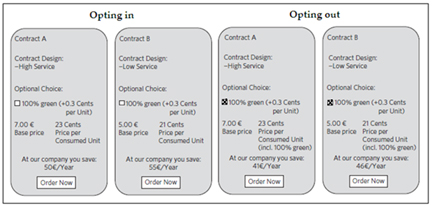Opting for green
Redesign of how options of energy use are presented is found to help consumers choose the green route, says S.Ananthanarayanan.
Going green, or choosing to use energy generated from renewable or non-polluting sources comes with some costs, and the challenge is get consumers to make the more responsible choice even if it is expensive. Choosing the more expensive way because it is
for the common good amounts to cooperation with society and surrendering a personal economy. The ‘natural’ or ‘logical’ choice may be to choose personal economy and not to bear higher costs which help others enjoy lower prices. This is the basis of market
economy and there is always an ‘optimum’ mix of cooperation and selfishness which drives human behaviour.
But global warming has forced the world into a corner and it is time to use every trick and stratagem possible to get consumers, and the industry and states, to consistently go for the personally expensive but socially imperative option of doing things
in the more sustainable way. In the context, the study by Felix Ebeling, from the University of Cologne and Sebastian Lotz from Stanford and the University of Lausanne, published in the journal Nature Climate Change, formally shows that a method of ‘nudging’
the consumer with a ‘default’ green choice at the time of exercising an option leads to a ten-fold increase in the number of consumers who do go for the sustainable but personally more expensive offer.
Green power
The paper describes an experiment in Germany, where a nation-wide energy supplier offers two products, one the normal energy connection, and the other, electricity from completely renewable sources, but priced about 15% higher. The energy comes in through
the same transmission line, of course, but if a consumer opts to buy ‘green’ power, then the supplier firm (the name is not disclosed) promises to increase the green component of the generation process used by the extent of the consumer’s contribution. The
contract for supply of power is entered into by consumers through the supplier’s website, where they are two screens, one for the normal service offered and the other for superior service, at higher cost. And each screen offers further choice – power from
the available sources or from fully renewable, ie, green sources, where the surcharge is added. If the consumer would like to take green energy, then she has to check the box that is provided.
Now, the experiment was in the way the choice of green energy was offered – the green energy check box was either left unchecked, in which case a consumer had to manually check the box (opt in) if she wanted green power, or the box came with a check mark,
a default option – and the consumer had to uncheck it (opt out) if she wanted cheaper power. A total of 41,952 households participated in the trial, over the length of a month and each household was randomly assigned either of the two tariff presentations.

The outcome at the end of the month was that the default presentation, where the green option was pre-selected and could be regarded as a ‘nudge’, resulted in significantly more green selection. While only some of the website visits resulted in a purchase
of power supply, in cases where green power had to be actually selected by ‘opting in’, only 0.62% of the total number of website visits were selections for green power, against 5.58% where the green option was ‘pre-selected’, and the consumer had to ‘opt
out’ if she so wished. This amounts to about nine times as many green selections where there was the ‘nudge’! Considering only the cases where there was an actual sale, the figures are that 7.2% opted for green power where they had to ‘opt in’, but 69.1%
stayed with green when they had to ‘opt out’. This also comes to a little more than nine times as many green options in the case where there was a ‘nudge’.
The results of the trial were also subjected to refinement, in terms of the choices depending on whether the consumer had chosen ordinary service or superior service and also where there were differences in the tariff rate itself. While there was a dip
in the preference for green during periods of reduced electricity consumption or where the rates were higher, the main conclusion, that calling for a ‘opt out’ option favours a choice of staying with green, was robustly borne out.
Another analysis carried out was of how the manner of presentation affected persons who started out with political commitment to green energy. The way this was done was by considering the postal code of subscriber homes and the political party that had
been returned by the majority of voters in that district. Absence of the ‘nudge’ results in the same, low rates of option for green energy, but with larger numbers (9.87%) where the ‘green party’was popular, and fewer (4.63%) where the party had less following.
But where there had been the ‘nudge’, by way of the pre-selected option, the rates of choosing green energy rose sharply, to 70.19% and 67.06% in ‘green party’ areas and areas with less followers, respectively..
Conscious choice
The next test applied is the more significant one – to see whether providing a pre-selected option somehow ‘fooled’ consumers into leaving it as it is, out of lack of awareness. In this test, the conditions that the German consumers faced while placing
their contracts were simulated using US based volunteers, through an on-line crowd sourcing service called Amazon Mechanical Turk, where anybody can volunteer, for some small payment, to take part in surveys and other business exercises. AMT volunteers based
in the US were thus asked to imagine they were entering into the power buying contract with the German utility. That they only imagined, and did not actually buy a contract, was the only difference and the screens presented were the same as used in Germany.
The AMT volunteers were hence also offered the green option, at a higher power tariff, and in different sets, either with the blank, ‘opt in’ box or the pre-filled ‘opt out’ box. And then, the important part, after the exercise was over, a subset of the participants
was asked to state whether they could remember what option they had chosen.
The results of the first part of the exercise were similar to the real life trial, with 34.16% and 93.8% of the participant opting for green energy in the ‘opt in’ and ‘opt out’ cases, respectively. But now, when participants were later asked if they remembered
how they had chosen, all those who had ‘opted in’ for green naturally remembered, but so also did 84.13% of those who chose green energy in the ‘opt out’ option. This shows that those who chose green energy, by not exercising the ‘opt out’ option, had done
so consciously.

Ebeling and Lotz observe that the experiment shows that using a default setting has a powerful effect on behavior, which gets households to opt for green alternatives without tax breaks or monetary compensation. Suggestions for desired behaviour, in the
form of non-binding defaults, which have their effect without infringing the right to free choice, have been found useful in different areas of social and economic policy, they note, an example being organ donation, where ‘opt out’ leads to high participation.
The same method, they say, can now form part of the policy maker’s tool-box to deal with climate change.
Options for India
Germany is an environmentally conscious state, which has given up nuclear power and where private electricity utilities offer choices of sources of power. But even in countries like India, there are a great many situations where there is need for people
to make green choices. Examples are in water use, using public transport, reducing the use of plastics, even refusing to be overcharged.
A modified ‘opt-out’ option, where the consumer needs to actively choose the obviously less sustainable practice, would draw attention to the nature of the choice and, as the Ebeling-Lotz experiment has shown, should promote green behaviour.